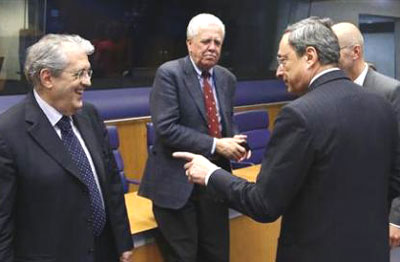
EU ministers to set bank bailout rules
London, June 20, 2013
Euro zone finance ministers are set to decide when and how their bailout fund can invest in a bank to save it from failure, a long-promised move that aims to break a downward spiral between bad banks and their indebted home countries.
Using the power of the 500-billion-euro bailout fund as a backstop for banks is aimed at restoring confidence in the sector, ravaged by three years of debt and financial crisis.
Policymakers hope it will in turn galvanize interbank lending and borrowing, so the wheels of the euro zone economy will start moving again after a lengthy recession.
The decision to allow the bailout fund to buy bank shares was made at the height if the crisis in June 2012 -- the Spanish banking sector needed tens of billions of euros and Madrid's borrowing costs were climbing fast, raising the prospect of it being cut out of the markets.
The European Central Bank has pacified markets since then with a commitment to buy unlimited amounts of government bonds to support the euro if needs be.
That calm has opened the way for Germany and others to put the brakes on sweeping banking sector reforms, which German Finance Minister Wolfgang Schaeuble feared would end up leaving Germany too much on the hook for others' problems.
The outcome on Thursday is likely to be an agreement that goes some distance to separating problem banks from their governments, but not as far as envisaged nine months or a year ago, a shortcoming that concerns some countries.
"France absolutely wants a deal on bank recapitalization ... this is a way to break the vicious circle between banking crises and sovereign crises," French Finance Minister Pierre Moscovici told reporters on arrival for the meeting.
Ministers from the 17 countries using the euro will set the budget for buying bank shares, how much a government would have to contribute to such a rescue, which banks would be eligible, and who would lose money in the process.
Draft guidelines prepared for the meeting showed that funds earmarked for purchases of bank shares might be limited to only a tenth of the bailout fund's firepower, that a government would always contribute to a rescue and that bank bondholders, even senior ones, might lose money.
This could limit the confidence boosting effect of the package since the earmarked amount would be small, sovereign liability curbed but not eliminated and the possibility of bondholder losses would raise bank financing costs.
The discussions on Thursday are separate, but closely linked to talks on Friday, when the euro zone ministers will be joined by colleagues from other European Union countries, on a broader law to rescue or close down a failing bank.
The bank recovery and resolution directive covers some similar ground to the guidelines on bailing out banks by the euro zone fund - for example who loses money and when, and if a bank should be rescued or wound down.
Guidelines for the bailout fund, to be agreed in principle on Thursday, will only be finalized in a legal form once the European Parliament votes through the directive.
The ministers will decide if the guidelines match EU state aid law that foresees losses only for shareholders and junior bondholders, or the still-not-finalized directive, where senior bondholders and large depositors could also take a hit.
The ESM bailout fund will be able to become a shareholder in a failing and systemically important bank only in the second half of the 2014, after the ECB establishes itself as the euro zone supervisor, now in September 2014.
To deal with banks that need recapitalizing because of bad assets accumulated earlier - legacy assets - the rules say that before the bailout fund can invest in a bank, its national government must top up the bank's capital so that it meets the legal minimum of common equity Tier 1 ratio of 4.5 percent.
If a bank meets that minimum requirement, the government would have to provide between 10 and 20 percent of the needed capital increase, in order to ensure the government has an interest in keeping the bank healthy.
On Thursday, the ministers are to decide what number from the 10-20 per cent range to pick.
They will also set a general rule on whether the bailout fund can take a decision in the second half of 2014 to become a shareholder in a bank that got into trouble before that date - what EU policymakers call retroactivity.
The options include all banks being eligible or none, or that they be evaluated on a case-by-case basis.
Ireland may be interested in the bailout fund buying stakes in its banks, as might Greece, Cyprus and Portugal, but Spain has said it would not seek such an option so as not to send a signal to the markets that the sovereign cannot cope on its own.-Reuters







